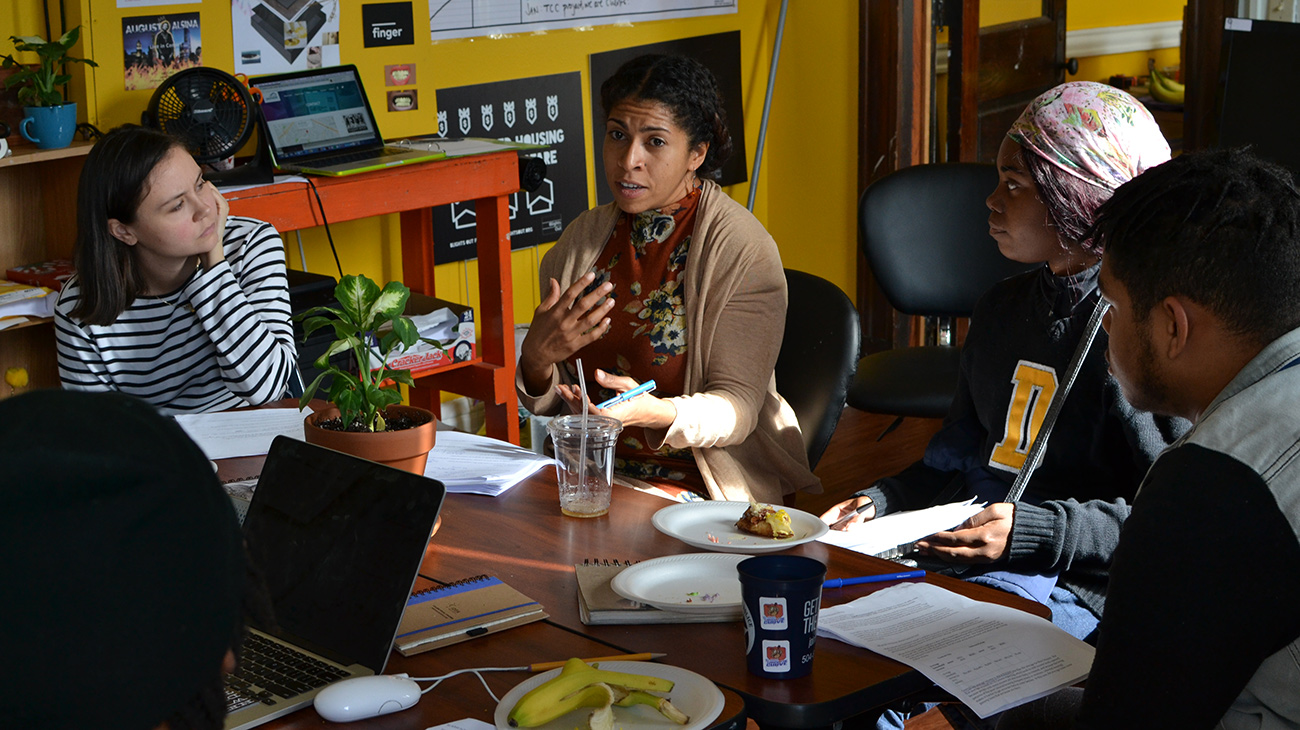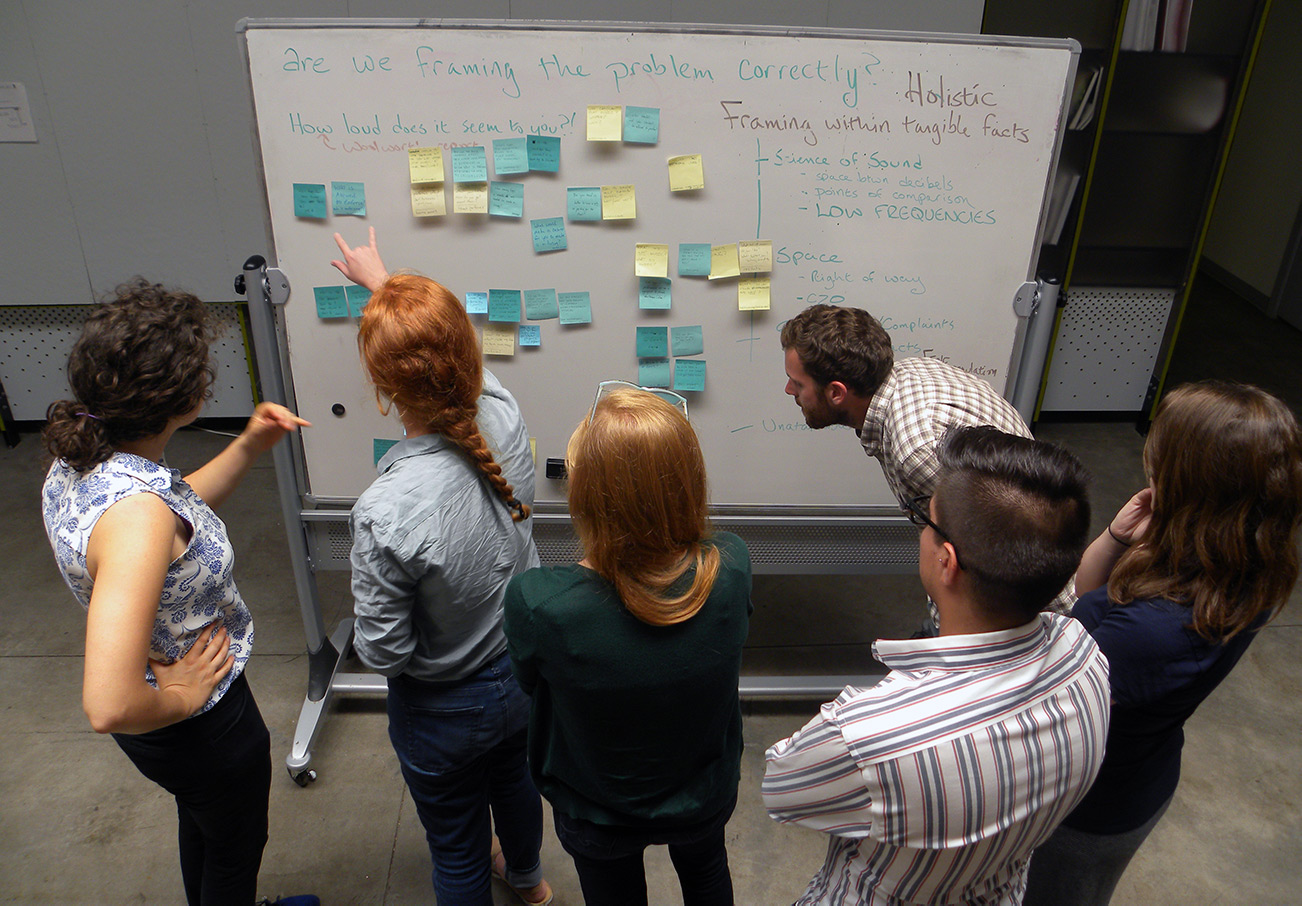Creating an ecosystem for social design in New Orleans
Nonprofit design practice Colloqate helps architects and laypeople alike understand the potential for a more just, equitable built environment.
April 4, 2019

In preparation for an exhibit at New Orleans's Small Center for Collaborative Design, Sue Mobley, center, prepares Tulane students to work as co-designers and researchers in local architecture firms.
Colloqate is a 2019 Emerging Voice.
By Sarah Wesseler
For Bryan Lee and Sue Mobley, architecture is never about just designing beautiful buildings—nor do they think that singular focus should that be a real option within the profession. Instead, they believe that designers have an obligation to focus on the greater good.
“I’m not of the opinion that we should have a choice,” Lee told me. “I think our work should be centered around doing social practice, and then the auxiliary high-fashion design work should be just that.”
Lee and Mobley are the directors of Colloqate, a New Orleans-based nonprofit design practice founded in 2017. Lee, an architect, and Mobley, a policy expert, view architecture not as an art form, but as an ecosystem of interrelated (and alliterative) nodes of power: pedagogy, policy, procedures, practice, projects, and people. What people are taught influences how policies are made. Policies (e.g., zoning regulations and building codes) then manifest themselves in procedures that shape designers’ practices and projects.
Today, this architectural ecosystem is fundamentally unhealthy, Colloqate believes. It not only fails to serve much of the world’s population, but actively worsens many of society’s greatest challenges. “For every injustice in this world, we say that there is an architecture that has been built to facilitate it,” said Lee. Prisons enable harsh penal systems. Carbon-intensive infrastructure hastens global warming. Luxury housing consumes resources that would be better used for affordable homes.
A more just architecture is not an impossible dream, Lee and Mobley maintain. Lee cites the Americans with Disabilities Act as a model for professional evolution. “That act of defiance by disability rights activists over many, many years changed how we interface with the built environment, those who are able-bodied and not,” he said. “We have to change systems at that institutional level.”

A note from President George H. W. Bush praises activist Justin Dart, right, for his critical role in the passage of the Americans with Disabilities Act. Bush signed the act into law in 1990.
But the first step is to recognize the need and potential for change. This is where Lee and Mobley have focused much of their efforts, both as Colloqate and individually. “We’re both educators by inclination,” Mobley said. “The way in which we frame projects for our team and for the folks that we work with is often around the idea of expanding and deepening knowledge.”
Working primarily in New Orleans, Lee and Mobley teach architecture students and laypeople alike. This public emphasis is critical to their work, as is the hometown focus. If people in a given city don’t understand architecture (or trust architects), there’s little chance of sustaining social design efforts there over time. But like most Americans, New Orleanians have received little education about design and the built environment. And while they see doctors, educators, and other professionals at work firsthand, they rarely interact with designers, reinforcing an impression of disciplinary distance and irrelevance. The relative scarcity of African American architects in this majority-black city presents another hurdle. “People don’t know architects,” Lee said. “People don’t know architects at all.”
In one attempt to shift this dynamic, Lee has spent much of the last decade working with an organization called Project Pipeline. Targeting high school students, Project Pipeline is a yearlong mentorship program that includes a summer camp, workshop series, and competition. “The goal was not necessarily to build more new architects,” Lee said. “It was actually, can we introduce more people to the aspects of architecture that are important to governing a city?” To date, approximately 1,200 students in New Orleans have gone through the program; at the national level, this figure rises to 10,000.
Mobley has also carried out a number of public education initiatives. While working at the Small Center for Collaborative Design, an off-campus branch of the Tulane School of Architecture, she created public exhibits and events exploring the city’s built, social, and natural environments. In addition to students and faculty members, the people who showed up to learn about issues like the history of public protests in New Orleans included “neighbors, and folks who worked in the area, and the seniors from the public housing complex around the corner,” she said. “And that, to me, was the best kind of teaching.”
Mobley was also embedded in design projects and design–build studios at Tulane, training architecture students in the fundamentals of social design. Her role grew out of a recognition of the need for a curriculum specifically addressing this work. “The school had shifted to wanting to be more involved in the city of New Orleans, and realizing that you can’t just send people out and say, ‘Do good.’” That’s incredibly unfair,” she said. “And you certainly can’t do it when kids are being asked to do that in a community that likely doesn’t resemble where they came from.” This “go forth and change the world” approach often results in frustrated, disillusioned architects, Mobley said. It can also actively harm the people they want to serve, eroding the trust that is critical to social design.
Her lessons emphasized the importance of centering people in all design work (as opposed to form or other considerations), as well as the need to recognize expertise among individuals of all kinds—particularly those who have been marginalized due to factors like race, age, or socioeconomic status. It can be difficult for architects to have their ideas questioned, particularly by people they’re not used to viewing as authorities. But social practice depends on listening carefully to individual voices and respecting their deep understanding of their context and needs.
In Mobley’s studio sessions, some students weren’t thrilled about being asked to learn social science research techniques or read hundreds of pages about local history. But after graduation, several have contacted her to say that although they didn’t understand at the time what these assignments had to do with architecture, the experience has proven invaluable in professional practice. “Which is all you could possibly ask for in educating,” she said.
This general sentiment has carried through to all of Colloqate’s work. Mobley expected pushback due to the practice’s oppositional stance; instead, the response within the architecture community and beyond has been overwhelmingly positive, she said. Lee and Mobley are often asked how architects with traditional practices can incorporate social design into their work, and they hope to launch a scalable teaching program soon.
In the meantime, Lee describes five principles that can help guide architects in social design. First, know who holds power within a community; second, know the injustices that result from that power. Then, commit to serving those who are disproportionately and directly impacted by injustice, and know how injustices manifest themselves in the built environment. Finally, be open to opportunities to challenge the system through design work at many scales.
The last principle speaks to Colloqate’s own experience. While Lee and Mobley intend to design buildings as the practice grows, they don’t accept the notion that their work to date falls outside the realm of architecture.
“The way in which it’s always framed is that [working with communities] is less than architecture,” Lee said. “Our aim is always to challenge the impression that this work is less than, and center it as a vital part of designing good buildings in this world.”
Explore
Office of Jonathan Tate lecture
Jonathan Tate describes his work on starter homes in New Orleans and beyond.
Mexico’s Traditional Housing Is Disappearing—and with It, a Way of Life
Mariana Ordóñez Grajales and Onnis Luque are fighting to preserve their country's vernacular architecture.
Maurice Cox lecture
Detroit's director of planning and development offers insight into the city's revitalization efforts.

